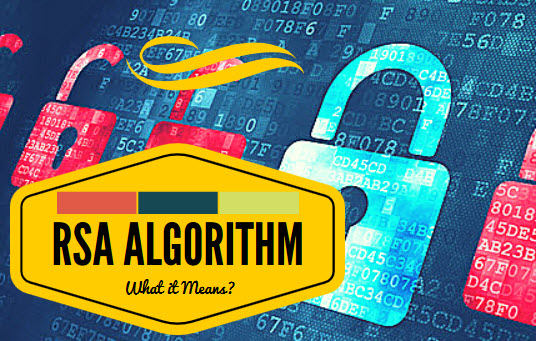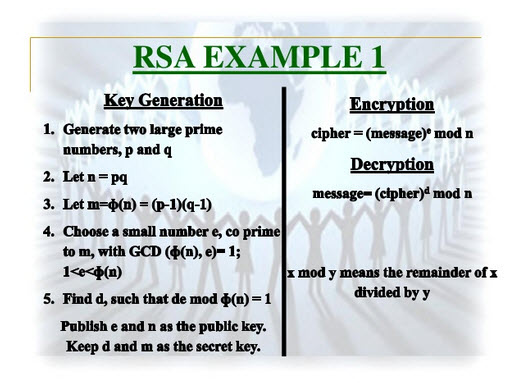The RSA Algorithm Explained Using Simple Pencil and Paper Method
August 14, 2003

OK, here is what we want to do: We have a "piece of data" that we want to somehow "scramble" so nobody can learn what this data is, and we want to send this data over unsecure lines to the recipient. Upon receipt of this scrambled data, the recipient must be able to "unscramble" this data to its original shape. The important thing here is that we want to do this "scrambling/unscrambling" process without requiring usage of any secret keys that both the sender and the recipient must posses in order to scramble and descramble the data. This is why the method we are going to discuss here is called "Public Key Cryptography". There are several Public Key Cryptography algorithms in use today. The most popular is called RSA algorithm, and is named after the initials of its inventors: R for Rivest, S for Shamir, and A for Adelman. By the way, they were students when they invented this algorithm in 1977. This is their picture
at the time.
So here is the summary of operations. Please continue reading below for the detailed explanation of how this is achieved. Let's say that your WEB Browser has a piece of data, say number 14 (we'll call it a Plain message and label it as P=14). and it wants to encrypt this Plain message first and then send it to the Server. Upon receipt of this encrypted message, the Server wants to decrypt it to its original value. Here is the summary of what transpires. Before any communication happens, the Server had calculated, in advance, its public (n =33 and k=7) and private (j=3) keys. Now, to initiate the transaction, the Browser sends this message to the server: Hey Server, please send me your public key. The Server obliges: Here it comes, it's n=33, k=7. After receiving the Server's public key, the Browser converts the Plain message P=14 into the Encrypted message E=20 and sends it to the Server. The Server receives this encrypted message E=20 and using its secret key j=3 (and publicly known key n=33) decrypts the E=20 message into its original Plain message P=14.
Now, let's look a bit more into the math behind all this.
Section1. Generating Public
and Private Keys
First, as we mentioned above, before any transmission happens, the
Server had calculated its public and secret keys. Here is how.
1.1) pick two prime numbers, we'll pick p = 3 and q = 11
1.2) calculate n = p * q = 3 * 11 = 33
1.3) calculate z = ( p - 1 ) * ( q - 1 ) = ( 3 - 1 ) * ( 11 - 1 ) = 20
1.4) choose a prime number k, such that k is co-prime to z, i.e,
z is not divisible by k. We have several choices for k: 7, 11, 13, 17, 19
(we cannot use 5, because 20 is divisible by 5). Let's pick k=7
(smaller k, "less math").
1.5) So, the numbers n = 33 and k = 7 become the Server's public key.
1.6) Now, still done in advance of any transmission, the Server
has to calculate it's secret key. Here is how.
1.7) k * j = 1 ( mod z )
1.8) 7 * j = 1 ( mod 20 )
1.9) ( 7 * j ) / 20 = ? with the remainder of 1 (the "?" here means:
"something, but don't wory about it"; we are only interested in the
remainder). Since we selected (on purpose) to work with small numbers,
we can easily conclude that 21 / 20 gives "something" with the remainder
of 1. So, 7 * j = 21, and j = 3. This is our secret key. We MUST NOT
give this key away.
Now, after the Server has done the above preparatory calculations in
advance, we can begin our message transmission from our Browser to the
Server. First, the Browser requests from the Server, the Server's
public key, which the Server obliges, i.e., it sends n=33 and k=7 back
to the Browser. Now, we said that the Browser has a Plain message
P=14, and it wants to encrypt it, before sending it to the Server. Here
is how the encryption happens on the Browser.
Section 2. Encrypting the message
Here is the encryption math that Browser executes.
2.1) P ^ k = E ( mod n )
"^" means "to the power of"
P is the Plain message we want to encrypt
n and k are Server's public key (see Section 1)
E is our Encrypted message we want to generate
After plugging in the values, this equation is solved as follows:
2.2) 14 ^ 7 = E ( mod 33 )
This equation in English says: raise 14 to the power of 7, divide this
by 33, giving the remainder of E.
2.3) 105413504 / 33 = 3194348.606 (well, I lied when I said that this
is "Pencil and Paper" method only. You might want to use a calculator
here).
2.4) 3194348 * 33 = 10541348
2.5) E = 105413504 - 10541348 = 20
So, our Encrypted message is E=20. This is now the value that the
Browser is going to send to the Server. When the Server receives this
message, it then proceeds to Decrypt it, as follows.
Section 3. Decrypting the
Message
Here is the decryption math the Server executes to recover the original
Plain text message which the Browser started with.
3.1) E ^ j = P ( mod n)
E is the Encrypted message just received
j is the Server's secret key
P is the Plain message we are trying to recover
n is Server's public key (well part of; remember that Server's public
key was calculated in Section 1 as consisting of two numbers: n=33 and
k=7).
After plugging in the values:
3.2) 20 ^ 3 = P ( mod 33 )
3.3) 8000 / 33 = ? with the remainder of P. So to calculate this
remainder, we do:
3.4) 8000 / 33 = 242.424242...
3.5) 242 * 33 = 7986
3.6) P = 8000 - 7986 = 14, which is exactly the Plain text message that
the Browser started with!
Well that's about it. While we did not discuss the theory behind the
formulae involved I hope that you got at least a basic idea of how the
public key cryptography using the RSA algorithm works.

Section 4. "Cracking the
Code"
The essential requirement of the Public Key Cryptography is that the
public and secret keys are mathematically related, but this
relationship must be made very hard to determine by an outsider.
As you saw in the preceding text, everything starts with p and
q, from which we calculated n. The public key consists of two numbers:
n and k, where k is calculated from z and z is calculated from p and q.
The secret key j, was calculated from k and z and, as we just
stated, k and z are calculated from p and q. It follows then,
that j is also calculated from p and q,which proves that the public and
private keys are mathematically related. So, if an outsider wanted to find the secret
key j, by only knowing n, he must break down n into the two prime numbers that were
used to produce it (remember that n = p * q). Now, here is the real
crux of the bisquit: Decomposing a very large n into p and q is really
difficult to do. It is easy with the small numbers that we have used in
our demonstration, but try, for example decomposing p into p and q when
p has several hundred digits. Well, if you have some free time on your hands, try
this challenge. You may even earn some money.


